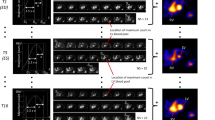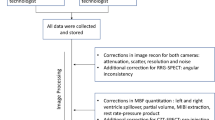Abstract
Background
The purpose of this study was to determine the accuracy of determinations of left ventricular ejection fraction (LVEF) by a nonimaging miniature nuclear detector system (Cardioscint) and to evaluate the feasibility of long-term LVEF monitoring in patients admitted to the coronary care unit, with special reference to the blood-labeling technique.
Methods and Results
Cardioscint LVEF values were compared with measurements of LVEF by conventional gamma camera radionuclide ventriculography in 33 patients with a wide range of LVEF values. In 21 of the 33 patients, long-term monitoring was carried out for 1 to 4 hours (mean 186 minutes), with three different kits: one for in vivo and two for in vitro red blood cell labeling. The stability of the labeling was assessed by determination of the activity of blood samples taken during the first 24 hours after blood labeling. The agreement between Cardioscint LVEF and gamma camera LVEF was good with automatic background correction (r=0.82; regression equation y=1.04x+3.88) but poor with manual background correction (r=0.50; y=0.88x−0.55). The agreement was highest in patients without wall motion abnormalities. The long-term monitoring showed no difference between morning and afternoon Cardioscint LVEF values. Short-lasting fluctuations in LVEFs greater than 10EF units were observed in the majority of the patients. After 24 hours, the mean reduction in the physical decay-corrected count rate of the blood samples was most pronounced for the two in vitro blood-labeling kits (57%±9% and 41%±3%) and less for the in vivo blood-labeling kit (32%±26%). This “biologic decay” had a marked influence on the Cardioscint monitoring results, demanding frequent background correction.
Conclusion
A fairly accurate estimate of LVEF cn be obtained with the nonimaging Cardioscint system, and continuous bedside LVEF monitoring can proceed for hours with little inconvenience to the patients. Instability of the red blood cell labeling during long-term monitoring necessitates frequent background correction.
Similar content being viewed by others
References
Broadhurst P, Utu XJ, Cashman PMM, Raftery EB, Lahiri A. Spontaneous variability of left ventricular ejection fraction assessed with the Cardioscint. Nucl Med Commun 1992;13:312–30.
Breisblatt WM, Schulman DS, Follansbee WP. Continuous on-line monitoring of left ventricular traction with a new nonimaging detector: validation and clinical use in the evaluation of patients post angioplasty. Am Heart J 1991;121:1609–17.
Broardhurst P, Cashin P, Crawlcy J, Raftery E, Lahiri A. Clinical validation of a miniature nuclear probe system for continuous on-line monitoring of cardiac function and ST-segment. J Nucl Med 1991;32:37–43.
Shephard JN, Underwood R, Evans TW. The application of a non-imaging nuclear probe system to the critical ill: laboratory validation and a clinical trial. Nucl Med Commun 1994;15:653–8.
Timmins AC, Giles M, Nathan AW, Hinds CJ. Clinical validation of a radionuclide detector to measure ejection fraction in critically ill patients. Br J Anaesth 1994;72:523–8.
Sridhara BS, Bhattacharya S, Liu XJ, Broardhurst P, Lahiri A. Rate of change of left ventricular ejection fraction during exercise is superior to the peak ejection fraction for predicting functionally significant coronary artery disease. Br Heart J 1993;70:507–12.
Kawasuji M, Takemura H, Tedoriya T, Sawa S, Taki J, Iwa T. Exercise response assessed by continuous monitoring of ventricular function in patients with coronary bypass operations. J Thorac Cardiovasc Surg 1992;103:849–54.
Breisblatt WM, Stein KL, Wolfe CJ, Follansbee WP, Capozzi J, Armitage JM, et al. Acute myocardial dysfunction and recovery: a common occurrence after bypass surgery. J Am Coll Cardiol 1990;15:1261–9.
Mohiuddin IK, Kambara H, Ohkusa T, Nohara R, Fudo T, One S, et al. Clinical evaluation of cardiac function by ambulatory ventricular scintigraphic monitoring (VEST): validation and study of the effects of nitroglycerin and nifedipine in patients with and without coronary artery disease. Am Heart J 1992; 123:386–94.
Kayden DS, Remetz MS, Cabin HS, Deckelbaum LI, Cleman MW, Wackero FJT, et al. Validation of continuous radionuclide left ventricular functioning monitoring in detecting silent myocardial ischemia during balloon angioplasty of the left anterior descending coronary artery. Am J Cardiol 1991;67:1339–43.
Zaret BL, Kayden DS. Ambulatory monitoring of left ventricular function: a new modality for assessing silent myocardial ischemia. In: Kellermann JJ, Braunwald E, editors. Silent myocardial ischemia: a critical appraisal. Basel: S Karger 1990:105–16.
Pfisterer M, Regenass S, Müller-Brand J, Burkart F. Ambulatory scintigraphic assessment of transient changes in left ventricular function: a new method for detection of silent myocardial ischaemia. Eur Heart J 1988;9:98–113.
Bland JM, Altman DG. Statistical methods for assessing agreement between two methods of clinical measurement. Lancet 1986;1:307–10.
Breisblatt WM, Weiland FL, McLain JR, Tomlinson GC, Burns MJ, Spaccavento LJ. Usefulness of ambulatory radionuclide monitoring of left ventricular function early after acute myocardial infarction for predicting residual myocardial ischemia. Am J Cardiol 1988;62:1005–10.
Berning J, Høilund-Carlsen PF, Gadsbøll N, Marring J, Hjort-Jensen B. Critical reappraisal of bedside echocardiographic parameters for estimation of left ventricular ejection fraction in acute myocardial infarction: importance of the wall motion index. Am J Noninvas Cardiol 1992;6:269–78.
Kayden DS, Wackers FJT, Zaret BL. Silent left ventricular dysfunction during routine activity after thrombolytic therapy for acute myocardial infarction. J Am Coll Cardiol 1990;15:1500–7.
Freeman MR, Yang L, Langer A, Foley B, Armstrong PW, Hsia T, et al. Frequency of transient reductions in left ventricular ejection reaction at rest in coronary artery disease. Am J Cardiol 1994;74:137–43.
Tamaki N, Yasuda T, Moore RH, Gill JB, Boucher CA, Hutter AM, et al. Continuous monitoring of left ventricular function by an ambulatory radionuclide detector in patients with coronary artery disease. J Am Coll Cardiol 1988;12:669–79.
Wackers FJT, Berger H, Weinberg M Zaret B Spontaneous changes in left ventricular function over the 24 hours of acute myocardial infarction: implication for evaluating early therapeutic interventions. Circulation 1982;66:748–54.
Larson SM, Hamilton GW, Richards P, Ritchie JL. Kit-labeled technetium-99mm red blood cells (Tc-99m-RBC’s) for clinical cardiac chamber imaging. Eur J Nucl Med 1978;3:227–31.
Davies GJ, Bencivelli W, Fragasso G, Chierchia S, Crea F, Crow J, et al. Sequence and magnitude of ventricular volume changes in painful and painless myocardial ischemia. Circulation 1988;78: 310–9.
Author information
Authors and Affiliations
Additional information
Supported by grants from the Willy and Ingeborg Reinhard Foundation and the Danish Heart Foundation.
Rights and permissions
About this article
Cite this article
Lindhardt, T.B., Hesse, B. & Gadsbøll, N. Monitoring of left ventricular ejection fraction with a miniature, nonimaging nuclear detector: Accuracy and reliability over time with special reference to blood labeling. J Nucl Cardiol 4, 147–155 (1997). https://doi.org/10.1016/S1071-3581(97)90064-7
Received:
Accepted:
Issue Date:
DOI: https://doi.org/10.1016/S1071-3581(97)90064-7




